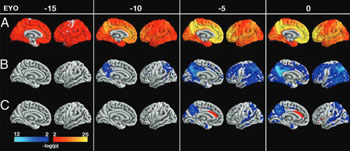PET Imaging Can Detect and Diagnose Early Alzheimer's Disease
By MedImaging International staff writers
Posted on 02 Jun 2016
A novel tracer called Pittsburgh Compound B (PiB) binds to the amyloid plaques in the brain that are a characteristic cause of Alzheimer's disease (AD), according to a new study.Posted on 02 Jun 2016
Professor Ann Cohen, MD, PhD, of the department of psychiatry at the University of Pittsburgh (Pitt, PA, USA) has presented a review that focuses on the use of PiB-PET across the spectrum of AD pathogenesis. PiB, a radioactive analog of thioflavin-T (ThT) known to bind to amyloid beta (Aβ)proteins, can be used to image the brains of AD patients using positron emission tomography (PET) scans in order to image the accumulation of Aβ plaques in neuronal tissue.

Image: Differences between carriers and noncarriers in PiB (A), FDG (B), and cortical thickness (C) at −15, −10, −5, and 0 years before predicted symptom onset (Photo courtesy of PNAS).
The review found that PiB can provide early, perhaps even preclinical, detection of disease, and accurately distinguishes AD from dementias of other etiologies in which the diagnostic distinction is difficult to make clinically. According to the study author, using imaging agents can be used to study the relationships between Aβ pathology and changes in cognition, brain structure, and function across the continuum from normal aging to mild cognitive impairment (MCI), and on to AD. The review was published in the June 2016 issue of Technology & Innovation.
“PiB retention in AD patients was generally most prominent in cortical areas and lower in white matter areas of the brain, consistent with post-mortem studies of Aβ plaques in the AD brain,” said study author Professor Cohen. “Major challenges ahead include finding ways to determine the earliest signs of amyloid accumulation, associating amyloid accumulation with cognitive impairments, and determining whether early amyloid deposition will lead to clinical dementia.”
“These challenges will likely require us to continue to focus on cognitively normal elderly and the detection of the earliest signs of amyloid deposition, along with markers of neurodegeneration...to determine the clinical significance of pre-symptomatic pathology," concluded Professor Cohen. “As anti-amyloid clinical trials begin in asymptomatic people, it will be critical to effectively identify the earliest changes in amyloid deposition and the significance of such changes on downstream neurodegenerative processes.”
Related Links:
University of Pittsburgh










 Guided Devices.jpg)



